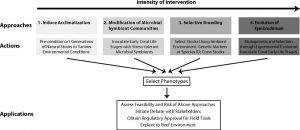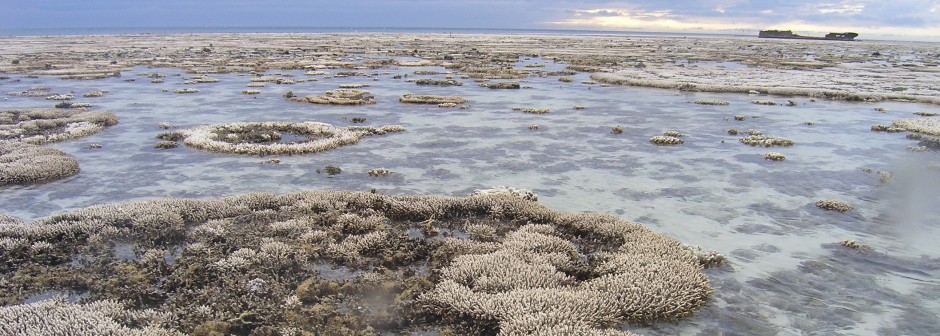With ocean temperatures rising and coral bleaching events becoming more and more common, attempts to reduce or reverse climate change may seem to be too little too late, and we are left wondering if there is anything that can be done to save the coral reefs.
One form of helping repair damaged reefs is to grow corals in nurseries and transplant them to the reef. This technique has been successful and useful for replanting damaged reefs.1 In coral nurseries, researchers, and therefore the corals, have access to greater, more controlled resources, which also allows greater protection from predation. Abiotic factors are those nonliving, physical and chemical attributes that can influence an environment or ecosystem. In some cases, abiotic factors that could be harmful can also be restricted in coral nurseries, such that temperatures, pH, light, and other factors are strictly controlled. However, if these corals are not suited to the natural environment in which they will eventually be placed, where temperature stress cannot be controlled, they still most likely will die.1
Assisted evolution, is the process whereby researchers help speed along natural selection through different methods to enable corals to be better equipped with traits that will allow them to survive predicted changes in ocean conditions. Dr. Madeline van Oppen and colleagues argue that assisted evolution may be extremely important in helping corals survive, despite rising ocean temperatures. They propose that there are four main ways that assisted evolution could be used in coral reefs, shown in figure 1. These researchers further state that all methods need more research to be developed well enough to be implemented.1

Fig. 1: The assisted evolution diagram shows the four proposed approaches to assisted evolution in order of increasing intensity of intervention and the actions that would be taken with each and how these methods would be applicable. Source: van Oppen et. al. 2015.
The first approach involves exposing corals to stressful conditions so that they will be better able to acclimate in the future.1It has been shown that exposing some corals to moderate light and temperature stress enables them to better resist bleaching during future stressful events.1 Exposure to stressful conditions may change corals’ sensitivity to heat stress through epigenetics, changing which gene is expressed and to what extent. Essentially, the corals are increasing their tolerance to conditions of unusual light and temperatures.
The second method of increasing coral resilience is through modifying the microbial community associated with coral.1 All corals live with other creatures in their ecosystems. When the creatures coexist in a mutually advantageous way, they are said to be symbiotic. Exposure to stress allows the corals to change the relative abundance of different types of symbiotic algae contained in their tissues in favor of a higher abundance of those symbionts more suited for future conditions.1 Symbiodinium are algae composed of one cell, that tend to live in harmony with corals. Their photosynthetic biproducts are used by the corals. Dr. Robert Rowan has shown that a group of Symbiodinium, called clade D, function better in higher temperature water than another group, clade C.3 When exposed to stressful temperature conditions, clade D exhibited better functioning of chlorophyll than clade C. These results indicate that high temperature causes photoinhibition of clade C, while it causes photoprotection in clade D.3 By introducing heat tolerant Symbiodinium to corals, the heat tolerance of the corals may actually increase.1
A third way that assisted evolution could benefit corals is by selective breeding. The authors suggest selective breeding only those individuals with higher heat tolerance and thereby speed along the process of natural selection.1 This approach has not been researched in corals; however, it could be done through selective breeding or hybridization of species.1 A naturally occurring Acropora hybrid, a coral found in the Caribbean, has occasionally shown increased fitness compared to the parent species.1 Because corals bred through either of these procedures would have unknown effects on the environment, these individuals would need to be raised in a lab to minimize threats to the naturally occurring ecosystem and to identify genotypes that are most suited to predicted future conditions.1 In addition, it is unknown if many phenotypic traits observed in corals are due to heritable genetic factors or environmental factors. Selective breeding would only work with heritable factors.1 What limited research exists only shows limited heritability for heat tolerance in coral.1 Corals that already exist on naturally warmer reefs could also be moved to naturally cooler reefs that are experiencing high temperatures and losing coral cover.1
Finally, it might be possible to artificially evolve and select for Symbiodinium that show greater heat tolerance.1 This might be done by inducing a high mutation rate in lab-grown Symbiodinium and raising them in stressful environments mimicking predicted future environments to select for those strains with the highest fitness.1 The well-suited strains could then be introduced to corals. This method is only theoretical at this point and has not been tried in corals.
This research no doubt has some ethical questions attached to it. Should we really be “playing God” and choosing what traits these organisms have? Or should we just allow nature to take its course, even though we humans are causing the rise in greenhouse gases, which subsequently leads to increased air and ocean temperatures?2 But there are also some very real ecological questions to be answered regarding assisted evolution. For instance, what effects would organisms that were bred in the lab have on native organisms, and could these organisms potentially harm other native species?1 Van Oppen and her colleagues admit that, while she does not propose drastic changes such as genetic engineering, but rather techniques more along the lines of artificial selection, there could be negative outcomes.1 They also believe that what types of intervention are involved, the potential risks to the ecosystem involved, the health of the coral, and projected future reef health all must be analyzed and considered before taking action to increase coral resilience.1
Even though these techniques seem to be promising ways that scientists can prepare corals for future conditions, it is still imperative that the issue of climate change be addressed. It is our job to do what we can to reduce our own contributions to climate change.
References:
- van Oppen, M.J.H., Oliver, J.K., Putnam, H.M., and Gates, R.D. (2015). Building coral reef resilience through assisted evolution. Proceedings of the National Academy of Sciences 112, 2307–2313.
- van Oppen, M.J.H., Gates, R.D., Blackall, L.L., Cantin, N., Chakravarti, L.J., Chan, W.Y., Cormick, C., Crean, A., Damjanovic, K., Epstein, H., et al. (2017). Shifting paradigms in restoration of the world’s coral reefs. Global Change Biology.
- Rowan, R. (2004). Coral bleaching: Thermal adaptation in reef coral symbionts. Nature 430, 742–742.

